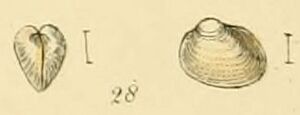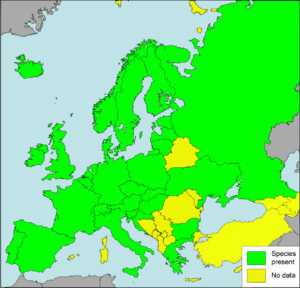Pea cockle facts for kids
Quick facts for kids Pea cockle |
|
|---|---|
 |
|
| Scientific classification | |
| Genus: |
Pisidium
|
| Species: |
casertanum
|
| Synonyms | |
|
Cardium casertanum Poli, 1791 |
|
The Pisidium casertanum, also known as the pea cockle or pea clam, is a tiny freshwater bivalve mollusc. It belongs to the Sphaeriidae family. These small creatures live in fresh water all around the world.
What Does the Pea Cockle Look Like?
The shell of the pea cockle is usually wide and shaped like a triangle or an oval. It has faint lines that go around it, like rings on a tree. The part of the shell that sticks out, called the umbos, is slightly behind the middle. The outer layer of the shell, called the Periostracum, feels smooth and silky but isn't very shiny. The shell itself can be whitish to grey-brown. Often, you might see it covered with reddish-brown dirt or deposits.
This pea cockle's shell looks a bit like another clam called Sphaerium novaezelandiae. However, the pea cockle is smaller when it's fully grown. It's also more rounded, has a deeper hinge (the part that connects the two halves of the shell), and stronger teeth inside. The ligament, which helps open and close the shell, isn't visible from the outside.
A full-grown pea cockle can be up to 4.5 millimeters long, 3.7 millimeters high, and 2.3 millimeters thick. That's smaller than a grain of rice!
Where Do Pea Cockles Live?
The pea cockle has a cosmopolitan distribution. This means it can be found almost everywhere in the world! It might even be the most widespread non-marine mollusc on Earth.
You can find Pisidium casertanum in many places, including:
- The British Isles, where it is very common.
- Ireland
- The Czech Republic, in both Bohemia and Moravia. Here, it is considered of "least concern," meaning it's not currently at risk.
- Slovakia
- Germany, where it is found throughout the country. However, in some areas like Hesse, it's highly endangered, and in Saxony, it's critically endangered. A specific type, Pisidium casertanum ponderosum, is also endangered in Brandenburg.
- Latvia
- The Netherlands
- New Zealand, where it is also common.
- The Nordic countries, including Denmark, the Faroes, Finland, Iceland, Norway, and Sweden.
- Poland


